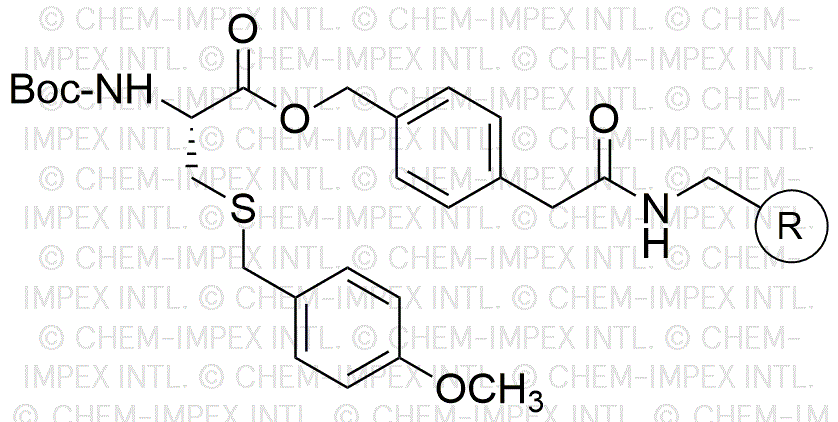Boc-S-4-methoxybenzyl-L-cysteine 4-oxymethylphenylacetamidomethyl is widely utilized in research focused on:
- Peptide Synthesis: This compound serves as a key building block in the synthesis of peptides, which are crucial for developing new drugs and therapeutic agents.
- Drug Development: It plays a significant role in the pharmaceutical industry for creating novel compounds that can target specific biological pathways, enhancing drug efficacy.
- Bioconjugation: Used in bioconjugation processes, it helps in attaching biomolecules to drugs or imaging agents, improving their delivery and effectiveness.
- Research in Cancer Therapy: This chemical is explored in studies aimed at developing targeted cancer therapies, offering potential advantages over traditional treatments.
- Antioxidant Studies: Its properties are investigated in research focused on antioxidants, contributing to the understanding of oxidative stress and related diseases.
Información general
Propiedades
Seguridad y normativas
Aplicaciones
Boc-S-4-methoxybenzyl-L-cysteine 4-oxymethylphenylacetamidomethyl is widely utilized in research focused on:
- Peptide Synthesis: This compound serves as a key building block in the synthesis of peptides, which are crucial for developing new drugs and therapeutic agents.
- Drug Development: It plays a significant role in the pharmaceutical industry for creating novel compounds that can target specific biological pathways, enhancing drug efficacy.
- Bioconjugation: Used in bioconjugation processes, it helps in attaching biomolecules to drugs or imaging agents, improving their delivery and effectiveness.
- Research in Cancer Therapy: This chemical is explored in studies aimed at developing targeted cancer therapies, offering potential advantages over traditional treatments.
- Antioxidant Studies: Its properties are investigated in research focused on antioxidants, contributing to the understanding of oxidative stress and related diseases.
Documentos
Hojas de datos de seguridad (HDS)
La SDS proporciona información de seguridad completa sobre la manipulación, el almacenamiento y la eliminación del producto.
Especificación del producto (PS)
La PS proporciona un desglose completo de las propiedades del producto, incluida la composición química, el estado físico, la pureza y los requisitos de almacenamiento. También detalla los rangos de calidad aceptables y las aplicaciones previstas del producto.
Certificados de análisis (COA)
Busque certificados de análisis (COA) ingresando el número de lote del producto. Los números de lote y de partida se pueden encontrar en la etiqueta de un producto después de las palabras "Lote" o "Lote".
Número de catálogo
Número de lote/lote
Certificados de origen (COO)
Este certificado de origen confirma el país en el que se fabricó el producto y también detalla los materiales y componentes utilizados en él y si se deriva de fuentes naturales, sintéticas u otras fuentes específicas. Este certificado puede ser necesario para cumplir con las normativas aduaneras, comerciales y regulatorias.
Número de catálogo
Número de lote/lote
Hojas de datos de seguridad (HDS)
La SDS proporciona información de seguridad completa sobre la manipulación, el almacenamiento y la eliminación del producto.
DownloadEspecificación del producto (PS)
La PS proporciona un desglose completo de las propiedades del producto, incluida la composición química, el estado físico, la pureza y los requisitos de almacenamiento. También detalla los rangos de calidad aceptables y las aplicaciones previstas del producto.
DownloadCertificados de análisis (COA)
Busque certificados de análisis (COA) ingresando el número de lote del producto. Los números de lote y de partida se pueden encontrar en la etiqueta de un producto después de las palabras "Lote" o "Lote".
Número de catálogo
Número de lote/lote
Certificados de origen (COO)
Este certificado de origen confirma el país en el que se fabricó el producto y también detalla los materiales y componentes utilizados en él y si se deriva de fuentes naturales, sintéticas u otras fuentes específicas. Este certificado puede ser necesario para cumplir con las normativas aduaneras, comerciales y regulatorias.


